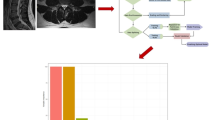Abstract
Purpose
Disc herniation in the lumbar spine is a common condition, so an automated method for diagnosis could be helpful in clinical applications. A computer-aided framework for disk herniation diagnosis was developed for use in magnetic resonance imaging (MRI).
Materials and Method
A computer-aided diagnosis framework for lumbar spine with a two-level classification scheme for disc herniation diagnosis was developed using heterogeneous classifiers: a perceptron classifier, a least mean square classifier, a support vector machine classifier, and a k-Means classifier. Each classifier makes a diagnosis based on a feature set generated from regions of interest that contain vertebrae, a disc, and the spinal cord. Then, an ensemble classifier makes a final decision using score values of each classifier. We used clinical MR image data from 70 subjects in T1-weighted sagittal view and T2-weighted sagittal view for evaluation of the system.
Results
MR images of 70 subjects were processed using the proposed framework resulting in successful detection of disc herniation with 99% accuracy, achieving a speedup factor of 30 in comparison with radiologist’s diagnosis.
Conclusion
The computer-aided framework works well to diagnose herniated discs in MRI scans. We expect the framework can be adapted to effectively diagnose a variety of abnormalities in the lumbar spine.
Similar content being viewed by others
References
Freymoyer JW (1999) Back pain and sciatica. N Engl J Med 318: 291–300
Brant-Zawadzki MN, Dennis SC, Gade GF, Weinstein MP (2000) Low back pain. Radiology 217: 321–330
Deyo RA, Mirza S, Martin BI (2002) Back pain prevalence and visit rates: estimates from US national surveys. Spine 31: 2724–2727
Cherry DK, Hing E, Woodwell DA, Rechtsteiner EA (2008) National Ambulatory Medical Care Survey: 2006 Summary. Natl Health Stat Report 3: 1–39
Beattie PF, Meyers SP (1998) Magnetic resonance imaging in low back pain: general principles and clinical issues. Phys Ther 78: 738–753
Sheehan NJ (2010) Magnetic resonance imaging for low back pain: indications and limitations. ARD 69: 7–11
Bhargavan M, Kaye AH, Forman HP, Sunshine JH (2009) Workload of radiologists in United States in 2006–2007 and trends since 1991–1992. Radiology 252(2): 458–467
Fardon DF, Milette PC (2001) Nomenclature and classification of lumbar disc pathology. Spine 26: E93–E113
Kim KY, Kim YT, Lee CS, Kang JS, Kim YJ (1993) Magnetic resonance imaging in the evaluation of the lumbar herniated intervertebral disc. Int Orthop 17: 241–244
Chwialkowski MP, Shile PE, Peshock RM, Pfeifer D, Parkey RW (1989) Automated detection and evaluation of lumbar discs in MR images. IEEE Eng Med Biol 2: 571–572
Milette PC (2000) Classification, diagnostic imaging, and imaging characterization of a lumbar herniated disk. Radiol Clin North Am 38: 1267–1292
Pfirrmann CWA, Metzdorf A, Zanetti JHM, Boos N (2001) Magnetic resonance classification of lumbar intervertebral disc degeneration. Spine 26: 1873–1878
Thalgott JS, Albert TJ, Vaccaro AR, Aprill CN, Giuffre JM, Drake JS, Henke JP (2004) A new classification system for degenerative disc disease of the lumbar spine based on magnetic resonance imaging, provocative discography, plain radiographs and anatomic considerations. Spine 4: 167S–172S
Griffith JF, Wang Y-XJ, Antonio GE, Choi KC, Yu A, Jhuja AT, Leung PC (2007) Modified pfirrmann grading system for lumbar intervertebral disc degeneration. Spine 32: E708–E712
Jarvik JG, Deyo RA (2002) Diagnostic evaluation of low back pain with emphasis on imaging. Ann Intern Med 137: 586–597
Graaf I, Prak A, Bierma-Seinstra S, Thomas S, Peul W, Koes B (2006) Diagnosis of lumbar spinal stenosis: a systematic review of the accuracy of diagnostic tests. Spine 31: 1168–1176
Koh J, Chaudhary V, Dhillon G (2010) Diagnosis of disc herniation based on classifiers and features generated from spine MR images. Proc SPIE 7624: 76243O
Koh J, Chaudhary V, Dhillon G (2010) A fully automated method of associating axial slices with a disc based on labeling of multi-protocol lumbar MRI. International Conference on Image Processing, pp 4341–4344. doi:10.1109/ICIP.2010.5652393
Koh J, Alomari RS, Chaudhary V, Dhillon G (2011) Lumbar spinal stenosis CAD from clinical MRM and MRI based on inter- and intra-context features with a two-level classifier. Proc SPIE 7963: 796304
Koh J, Scott PD, Chaudhary V, Dhillon G (2011) An automated segmentation method of the spinal canal from clinical MR images based on an attention model and an active contour model. IEEE International Symposium on Biomedical Imaging, pp 1467–1471. doi:10.1109/ISBI.2011.5872677
Bhole C, Kompalli S, Chaudhary V (2009) Context-sensitive labeling of spinal structures in MRI images. Proc SPIE 7260: 72603P
Koh J, Kim T, Chaudhary V, Dhillon G (2010) Automatic segmentation of the spinal cord and the dural sac in lumbar MR images using gradient vector flow field. In: Data mining: practical machine learning tools and techniques, 3rd edn. International Conference on IEEE Engineering in Medicine and Biology Society, pp 2117–2120
Witten IH, Frank E, Hall MA (2011) Data mining: practical machine learning tools and techniques, 3rd edn. Morgan Kaufmann, Burlington
Author information
Authors and Affiliations
Corresponding author
Additional information
This work is in part supported by grants from NSF and NYSTAR.
Rights and permissions
About this article
Cite this article
Koh, J., Chaudhary, V. & Dhillon, G. Disc herniation diagnosis in MRI using a CAD framework and a two-level classifier. Int J CARS 7, 861–869 (2012). https://doi.org/10.1007/s11548-012-0674-9
Received:
Accepted:
Published:
Issue Date:
DOI: https://doi.org/10.1007/s11548-012-0674-9




